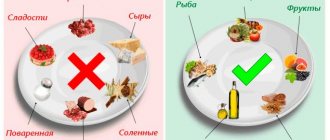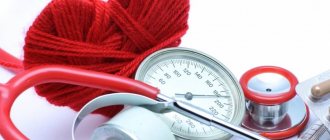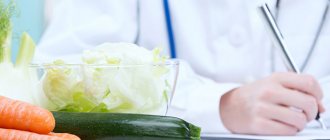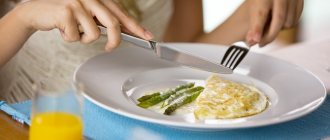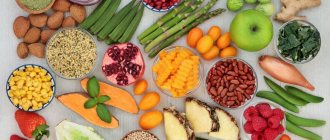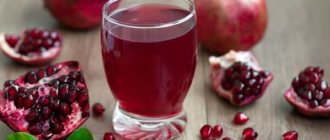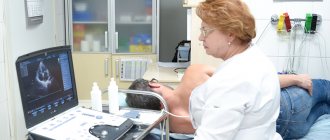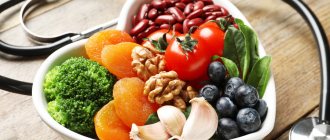Example menu
The first day:
- First breakfast: freshly squeezed juice, a portion of oatmeal with water, 1 boiled egg, cabbage, cucumber and red pepper salad.
- Second breakfast: grated carrots with honey.
- Lunch: pasta made from durum wheat flour, beet salad with nuts.
- Afternoon snack: 35 g almonds, a glass of blueberries.
- Dinner: seafood soup, vegetable stew.
- Second dinner: 250 ml of kefir 0–1% fat.
Second day:
- First breakfast: weak green tea without sugar with lemon and honey, buckwheat porridge with bell pepper, dill and broccoli.
- Second breakfast: several fresh apples.
- Lunch: vegetarian borscht, a piece of black bread, dried fruit compote.
- Afternoon snack: 150 g of cottage cheese with the addition of dried apricots.
- Dinner: 120 g of steamed fish, a side dish of boiled vegetables with vegetable oil.
- Second dinner: yogurt with berries.
Day three:
- First breakfast: fresh juice, buckwheat porridge, vinaigrette, rose hip decoction.
- Second breakfast: salad of cabbage, apples, cucumbers and carrots, seasoned with vegetable oil.
- Lunch: a cup of vegetable soup, 130 g of fruit jelly.
- Afternoon snack: a bunch of grapes.
- Dinner: boiled fish with mashed potatoes and vegetable oil.
- Second dinner: yogurt.
Day four:
- First breakfast: fruit salad.
- Second breakfast: milkshake with banana.
- Lunch: beetroot soup, baked potatoes, tomato juice.
- Afternoon snack: baked apples, uzvar.
- Dinner: barley porridge with seaweed.
- Second dinner: yogurt.
Day five:
- First breakfast: oatmeal with berries, hawthorn tea.
- Second breakfast: salad of fresh tomatoes and cucumbers with herbs, dressed with vegetable oil.
- Lunch: potato and carrot puree soup with sour cream.
- Afternoon snack: sandwich with fresh tomato and canned salmon.
- Dinner: corn porridge with fish cutlet, stewed cabbage with prunes.
- Second dinner: yogurt.
Day six:
- First breakfast: two-white omelette with herbs, chicory with the addition of skim milk.
- Second breakfast: carrot and beet salad, cottage cheese casserole.
- Lunch: seafood soup.
- Afternoon snack: apple with cinnamon and cottage cheese, baked in the oven.
- Dinner: steamed fish cutlets, mashed potatoes.
- Second dinner: salad of grated carrots and apples.
Day seven:
- First breakfast: a couple of oatmeal pancakes with a spoon of honey, an orange.
- Second breakfast: tea with a handful of dates.
- Lunch: A bowl of soup with turkey meatballs.
- Afternoon snack: a few slices of melon.
- Dinner: salad of lettuce, tomatoes and boiled shrimp.
- Second dinner: weak green tea and some dried fruits.
Basics of nutrition for coronary artery disease and angina pectoris
The main rule of therapeutic nutrition for ischemic heart disease is the combination of the caloric content of the consumed diet and the patient’s energy expenditure. Since physical activity, as a rule, decreases significantly during illness, the calorie intake, accordingly, must be reduced. If a patient begins to gain weight, it means that he is consuming many more calories than he is expending.
Healthy foods
The patient's daily diet should include 30 ml of natural vegetable oil (it is advisable to choose olive, sunflower or corn). In case of individual intolerance, it can be replaced with special varieties of margarine. One of the conditions for choosing proper nutrition is to consume a sufficient amount of fiber, which is found in cereals, cereals, wholemeal bread and bran loaves, raw vegetables and fruits. Your diet should include seafood every day: kelp, any fish, shrimp.
Food restrictions
Patients with ischemia are restricted from consuming dairy and animal fats.
Patients should avoid excessive consumption of sugar, as well as sweet baked goods and drinks. You can allow 50 g of sugar per day, because sweets are not irreplaceable and necessary food products. That is why they can be completely removed from the diet.
Information! Salt consumption should also be limited. All dishes must be prepared without salt, adding only 0.5 teaspoon to the finished dish. Products such as cheeses, smoked sausages, salted fish, etc. are undesirable for consumption, and sometimes simply contraindicated.
When foods are heated, especially when fried, their medicinal and beneficial properties are completely lost and even become harmful, producing “bad” cholesterol. To avoid this, it is necessary to completely exclude from the diet the internal organs of animals (liver, kidneys, heart, lungs, brains), red and black caviar, fatty cheeses and fried chicken eggs.
Nutritional Features
Products for cardiac ischemia should contain increased amounts of vitamin C. It prevents vasoconstriction, has a relaxing effect on the arteries, reducing pressure, and also reduces the permeability of blood vessels.
In addition, it is a powerful antioxidant. The menu includes foods rich in potassium, magnesium, iodine, manganese and zinc. The body also needs methionine, an essential amino acid that is part of proteins, and B vitamins. The introduction of seafood, rich in cholesterol that is beneficial for the human body, into the diet is also necessary.
What do they enrich the diet with?
To improve the condition of coronary artery disease, eat foods that help remove cholesterol from the body:
- fish - it does not contain cholesterol, but contains polyunsaturated fatty acids (omega-3 and omega-6), which have a beneficial effect on the walls of blood vessels and destroy cholesterol accumulations and plaques. You can consume any types of fish, even fatty ones (flounder, mackerel);
- fresh vegetables and fruits - rich in fiber, which enhances intestinal motor function, quickly removes cholesterol and other harmful products of intestinal metabolism;
- cereals - buckwheat, wheat and oatmeal - contain a huge amount of useful vitamins and minerals, help the body cope with excess cholesterol;
- bran - used as a food additive in ready-made dishes, but not more than 3 tbsp. l. in a day.
It is important to consume large amounts of vitamins B, C and P. They restore damaged walls of coronary vessels, reduce their fragility and prevent rapid aging of myocardial cells. B vitamins strengthen the heart and increase its elasticity. An excess of such substances may not only not have the necessary effect, but also harm the general condition of the body.
Allowed foods
Nutrition for angina pectoris includes foods that do not contradict the listed general principles of a healthy diet. These include:
- porridge (wheat, buckwheat, millet, oatmeal, barley);
- dried fruits (dried apricots, raisins, prunes);
- fresh or baked fruits and vegetables;
- vegetable oils;
- fish, seaweed;
- dietary types of meat (game, chicken, turkey);
- dairy products;
- honey.
All of them are rich sources of microelements (phosphorus, calcium, magnesium, iron, potassium, sodium, zinc) and vitamins. In the human body, they normalize metabolism and establish its balance. If angina pectoris is diagnosed, then the diet includes more different leafy vegetables, for example, cabbage, parsley, spinach. You can remove excess cholesterol from the body by daily eating food with coarse fibers, which mechanically cleanse the intestines, slowing down the process of vascular damage. Water balance is achieved by drinking a couple of liters of water per day.
What foods should not be consumed if you have IHD?
It is important that the diet during ischemia is complete, and at the same time does not contain products from the “harmful” list, and this is:
- animal fats containing cholesterol and saturated fats (with the exception of some lard);
- fried foods and smoked foods, which burden the digestive system and stimulate excessive appetite;
- cheese - because it contains cholesterol;
- meat by-products in the form of liver, kidneys and heart, since they contain cholesterol and cause obesity;
- carbohydrate cereals - rice, semolina - because they lead to excess weight;
- pasta and flour products made from first and highest grade flour;
- fatty fish, as it contains saturated fats that transform into cholesterol;
- easily digestible desserts;
- alcoholic drinks and soda - they provoke appetite and negatively affect vascular tone;
- strong coffee, tea - they are stimulants of the central nervous system and cardiovascular system, causing them to overload.
Product selection
The key point in the diet is the correct choice of foods, because some of them are prohibited, others are acceptable in small quantities, and others should prevail in the daily menu. Each option should be considered separately.
Prohibited
It is necessary to exclude those foods that increase cholesterol levels in the blood, impair blood circulation and promote the formation of blood clots, which impede blood flow and impair the nutrition of the heart muscle. These are:
- fatty meats, such as pork and lamb;
- fatty poultry - duck, goose;
- sausages;
- offal, including liver and brains;
- smoked meats;
- pickles;
- cream;
- fried eggs;
- flour and confectionery products;
- chocolate;
- ice cream;
- lemonade and sweet carbonated drinks;
- alcohol.
The listed products are also prohibited due to their high content of easily digestible carbohydrates, which are often the cause of obesity.
Limited
There are foods that can be consumed in limited quantities:
- Proper nutrition of a patient with heart failure and edema
- drinks with a high caffeine content (coffee, strong tea) - 1-2 cups per day, as they have a strong diuretic effect and remove a lot of fluid from the body;
- fatty fish (mackerel, trout, sardine), seafood – up to 3-4 times a week;
- meat (beef, veal, turkey, rabbit) – once a week;
- eggs, chicken - up to 2-3 times a week;
- salt - up to 5-6 g per day, since it prevents the removal of fluid from the body.
Any leafy green is worth using as a salt substitute as it contains vitamins A, B, C and PP, as well as many minerals, including folic acid, phosphorus, calcium, potassium and iron.
Recommended
The basis of the daily diet consists of products that meet the following criteria:
- contain minerals (phosphorus, calcium, magnesium, iron, potassium, sodium, zinc);
- are sources of vitamins A, B, C, E, PP;
Vitamin C is especially useful for angina, which is a strong antioxidant, prevents blood vessels from narrowing, reduces their permeability and has a relaxing effect on the arteries.
- rich in fiber and coarse fibers, which remove excess “bad” cholesterol from the body, cleanse the intestines, normalize metabolism, and slow down the process of vascular damage.
The following products meet these criteria:
- beans, bran and cereals (especially oatmeal, buckwheat, millet, barley);
- milk and fermented milk products are valuable sources of lactose, thiamine, vitamin A, calcium;
- vegetables, especially leafy vegetables (any cabbage, spinach);
- fruits, especially banana, as it is high in potassium;
- vegetable oils (sunflower, olive, corn) – sources of mono- and polyunsaturated fats, as well as vitamins A, D, E, K and F, involved in cell formation and metabolism;
- nuts (walnuts, almonds, hazelnuts);
- honey, since it is a valuable source of potassium and successfully replaces sugar;
- dried fruits (raisins, prunes, dried apricots).
It is worth noting that this set of products requires a therapeutic diet - table No. 10. It is anti-atherosclerotic and is prescribed to normalize metabolism, reduce blood clotting and restore the metabolism of blood vessels and heart muscle.
Fully or partially limited products
- Exclude products made from puff pastry, pastries, cakes, cream pies, confectionery (sweets, waffles, halva, chocolate), sugar, jam, ice cream, white rice, semolina.
- Highly extractive meat/fish/mushroom broths.
- Fatty meats, cooking fats, mayonnaise, margarine, kidneys, brains, liver, sausages, canned food and smoked meats.
- Fatty dairy products.
- Canned fish, caviar, smoked fish.
Limit egg yolks, strong tea and coffee, cocoa, grapes, honey, raisins.
Table of prohibited products
| Proteins, g | Fats, g | Carbohydrates, g | Calories, kcal | |
Vegetables and greens | ||||
| radish | 1,2 | 0,1 | 3,4 | 19 |
| white radish | 1,4 | 0,0 | 4,1 | 21 |
| red radish | 1,2 | 0,1 | 3,4 | 20 |
| black radish | 1,9 | 0,2 | 6,7 | 35 |
| spinach | 2,9 | 0,3 | 2,0 | 22 |
| sorrel | 1,5 | 0,3 | 2,9 | 19 |
Fruits | ||||
| bananas | 1,5 | 0,2 | 21,8 | 95 |
Berries | ||||
| grape | 0,6 | 0,2 | 16,8 | 65 |
Mushrooms | ||||
| mushrooms | 3,5 | 2,0 | 2,5 | 30 |
Nuts and dried fruits | ||||
| raisin | 2,9 | 0,6 | 66,0 | 264 |
Cereals and porridges | ||||
| semolina | 10,3 | 1,0 | 73,3 | 328 |
| rice | 6,7 | 0,7 | 78,9 | 344 |
Flour and pasta | ||||
| pasta | 10,4 | 1,1 | 69,7 | 337 |
Confectionery | ||||
| jam | 0,3 | 0,2 | 63,0 | 263 |
| jam | 0,3 | 0,1 | 56,0 | 238 |
| candies | 4,3 | 19,8 | 67,5 | 453 |
| pastry cream | 0,2 | 26,0 | 16,5 | 300 |
| cookie | 7,5 | 11,8 | 74,9 | 417 |
Ice cream | ||||
| ice cream | 3,7 | 6,9 | 22,1 | 189 |
Cakes | ||||
| cake | 4,4 | 23,4 | 45,2 | 407 |
Chocolate | ||||
| chocolate | 5,4 | 35,3 | 56,5 | 544 |
Raw materials and seasonings | ||||
| mustard | 5,7 | 6,4 | 22,0 | 162 |
| mayonnaise | 2,4 | 67,0 | 3,9 | 627 |
Dairy | ||||
| milk 3.6% | 2,8 | 3,6 | 4,7 | 62 |
| milk 4.5% | 3,1 | 4,5 | 4,7 | 72 |
| cream | 2,8 | 20,0 | 3,7 | 205 |
| sour cream 25% (classic) | 2,6 | 25,0 | 2,5 | 248 |
Cheeses and cottage cheese | ||||
| cheese | 24,1 | 29,5 | 0,3 | 363 |
| cottage cheese 11% | 16,0 | 11,0 | 1,0 | 170 |
| cottage cheese 18% (fat) | 14,0 | 18,0 | 2,8 | 232 |
Meat products | ||||
| pork | 16,0 | 21,6 | 0,0 | 259 |
| pork liver | 18,8 | 3,6 | 0,0 | 108 |
| pork kidneys | 13,0 | 3,1 | 0,0 | 80 |
| pork fat | 1,4 | 92,8 | 0,0 | 841 |
| salo | 2,4 | 89,0 | 0,0 | 797 |
| beef liver | 17,4 | 3,1 | 0,0 | 98 |
| beef kidneys | 12,5 | 1,8 | 0,0 | 66 |
| beef brains | 9,5 | 9,5 | 0,0 | 124 |
Sausages | ||||
| smoked sausage | 16,2 | 44,6 | 0,0 | 466 |
| smoked sausage | 9,9 | 63,2 | 0,3 | 608 |
| sausages | 10,1 | 31,6 | 1,9 | 332 |
| sausages | 12,3 | 25,3 | 0,0 | 277 |
Bird | ||||
| smoked chicken | 27,5 | 8,2 | 0,0 | 184 |
| duck | 16,5 | 61,2 | 0,0 | 346 |
| smoked duck | 19,0 | 28,4 | 0,0 | 337 |
| goose | 16,1 | 33,3 | 0,0 | 364 |
Fish and seafood | ||||
| smoked fish | 26,8 | 9,9 | 0,0 | 196 |
| salted fish | 19,2 | 2,0 | 0,0 | 190 |
| Red caviar | 32,0 | 15,0 | 0,0 | 263 |
| black caviar | 28,0 | 9,7 | 0,0 | 203 |
| canned fish | 17,5 | 2,0 | 0,0 | 88 |
| cod (liver in oil) | 4,2 | 65,7 | 1,2 | 613 |
Oils and fats | ||||
| animal fat | 0,0 | 99,7 | 0,0 | 897 |
| cooking fat | 0,0 | 99,7 | 0,0 | 897 |
Non-alcoholic drinks | ||||
| instant coffee dry | 15,0 | 3,5 | 0,0 | 94 |
| black tea | 20,0 | 5,1 | 6,9 | 152 |
| * data is per 100 g of product | ||||
The essence and rules of the diet
Angina pectoris is one of the manifestations of coronary heart disease that develops due to atherosclerosis. The disease occurs when fat metabolism is disrupted - the body receives a lot of fatty fats, which contribute to the formation of “bad” cholesterol, which is deposited on the walls of blood vessels in the form of atherosclerotic plaques. Thus, the lumen of blood vessels decreases, so the heart muscle receives insufficient oxygen, and chronic oxygen starvation gradually develops.
By correcting your diet, you can prevent the progression of angina pectoris. This requires compliance with the following rules:
- Diet for blood type 2 negative: food table and diet
- with a normal initial weight, reduce the daily calorie content to 2800-2900 kcal, and correctly distribute the chemical composition of the diet: proteins - up to 100 g, fats - up to 90 g, carbohydrates - up to 350 g;
- if you are overweight, reduce your daily caloric intake so that it does not exceed 2000 kcal, with the amount of fat per day up to 70 g, and carbohydrates up to 300 g;
- switch to fractional meals - in addition to the 3 main meals, you can have 1-2 snacks, and the diet should be varied, including products of predominantly plant origin;
- maintain the correct water regime - drink about 2 liters of liquid during the day;
- exclude fats of animal origin from the diet, with the exception of fatty sea fish and seafood, since they contain omega-3 acids, which have a positive effect on cholesterol metabolism;
- prepare food through proper heat treatment, such as stewing, boiling and steaming, but frying is not recommended.
By following these rules, you can get rid of extra pounds and maintain a healthy weight. This will improve metabolic processes in the body, avoid the development of complications of angina pectoris and maintain stable health.
Folk remedies
The following food products, prepared according to folk recipes, will help in the treatment and prevention of coronary artery disease:
- The following recipe has a very good effect on normalizing heart activity in case of coronary artery disease. Take 2 tsp. sour cream, 1 tsp. honey, 2 eggs without yolks. Beat the egg whites and sour cream, then add honey to the mixture. Use in the morning before breakfast for ischemic heart disease.
- To prepare the product you will need 1 teaspoon of ground horseradish and linden honey. Mix everything and eat immediately with water 60 minutes before breakfast. It is recommended to take the product for a month, maybe a month and a half. It is best to do this in the spring or autumn, when exacerbation of ischemic heart disease is possible.
One of the main reasons for the occurrence and development of IHD is a weakness for fried, smoked, fatty, and floury foods. But a diet will help improve a person’s life and health; it should not be violated, especially if your doctor has prescribed it for you.
Nutrition for coronary heart disease
General description of the disease
Coronary heart disease (CHD) is a disease in which the blood supply to the heart muscle is completely or partially disrupted. Accordingly, oxygen delivery and nutrition of the myocardium are disrupted. As a result, a malfunction occurs in the functioning of cardiomyocytes (myocardial cells).
Coronary heart disease ranks first in the number of diseases and deaths worldwide. This group of diseases includes angina pectoris (“angina pectoris”), cardiosclerosis, myocardial infarction and heart failure.
Causes of coronary heart disease
Conventionally, all risk factors for the development of coronary artery disease can be divided into the following groups:
- 1 Biological – age, gender, hereditary predisposition. Older people and men are more likely to get sick.
- 2 Physiological – lipid metabolism disorders and obesity, diabetes mellitus, high blood pressure.
- 3 Lifestyle. Coronary heart disease is classified as a so-called “disease of civilization,” which is associated with a sedentary lifestyle and lack of dietary fiber (fiber, pectin) in the diet. Often, bad habits such as alcohol and smoking can trigger the development of this disease.
The immediate cause of IHD is a disorder of cholesterol metabolism, which is accompanied by the formation of atherosclerotic plaques - compacted formations. As a result, they are deposited on the inner walls of large and small blood vessels and subsequently lead to their narrowing. The most dangerous is the reduction in the lumen of the coronary arteries - the vessels that provide blood supply and nutrition to the myocardium.
Angina pectoris: principles of diet therapy
Nutrition for coronary heart disease should be complete and balanced: you cannot completely remove foods that are vital, but adversely affect blood vessels. You can’t severely limit your diet, dividing food into harmful and healthy. A rational approach to nutrition for angina pectoris involves choosing dishes and products that are a priority and mandatory. But with strict adherence to the doctor’s recommendations regarding quantity and volume. Basic principles of diet therapy for angina pectoris:
- reducing caloric intake, the approach to which is individual and depends on the initial obesity;
- limiting table salt to the level specified by the doctor;
- pronounced restriction of fatty foods in the diet with the obligatory exclusion of animal products;
- removing foods high in cholesterol from the diet;
- introduction of foods containing polyunsaturated fatty acids into the diet;
- restriction in food of animal proteins (any type of meat, eggs, milk) with the introduction of vegetable protein into the diet;
- removal of fast carbohydrates (sugar, glucose) from food with a predominance of plant foods in the diet;
- a sufficient supply of vitamins and microelements to the human body should be provided by vegetables, fruits and berries;
- It is better to avoid fried, canned and pickled foods, giving preference to stewed, boiled and baked dishes;
- the entire daily amount of food should be divided into 5-6 small portions;
- If you are obese, it is advisable to have a fasting day (fruit, vegetable, kefir) once a week.
If angina pectoris is detected, then it is advisable to adhere to the Mediterranean type of diet. It is this diet option that allows you to effectively prevent problems with blood vessels. Features of Mediterranean nutrition:
- eating more bread than with any other diet;
- a fairly pronounced predominance of root vegetables and green vegetables in food;
- reducing the amount of meat (beef, pork and lamb) in a diet with a predominance of poultry meat;
- a significant increase and predominance of olive oil in food;
- frequent consumption of fish and seafood;
- replacing fatty butters and cream with margarine;
- daily consumption of small doses of red wine.
| Rational principles of diet for angina pectoris |
| Products containing animal fats and saturated fatty acids should make up less than 10% of the total diet. It is optimal to replace them with foods rich in polyunsaturated fatty acids (olive oil, fatty fish) |
| It is advisable to almost completely eliminate trans fats (artificially created fatty acids) from the diet. |
| Table salt in food should not exceed 5 grams per day |
| You need a sufficient amount of fiber in your diet (40-45 grams), obtained from grains, cereals, vegetables and fruits |
| There should be 200 grams of different varieties of fruits and vegetables per day, divided into 2-3 doses |
| It is necessary to consume fatty varieties of sea fish at least 2 times a week |
| A small amount of alcohol is allowed (1 glass of dry red wine) per day |
Diet therapy for coronary artery disease will help reduce the load on the heart by losing weight and improving blood flow through the vessels of the heart. In addition, a balanced diet will become an essential factor in the treatment of high blood pressure and existing diabetes mellitus.
It is important to accurately and consistently follow your doctor’s recommendations to optimize your eating behavior, trying to avoid serious diet violations. Strict adherence to a diet for angina pectoris will significantly reduce the drug load and will be the first step towards recovery.
Fasting days
An example menu for a patient for a week is as follows.
On Monday morning you can eat oatmeal porridge with berries and drink a glass of cherry juice. Lunch consists of steamed chicken meatballs with millet, rye bread and a green apple. The evening meal includes boiled beef, salad and low-fat kefir.
On Tuesday, oatmeal pancakes, honey, and weakly brewed tea are offered for breakfast. During the day you can eat potatoes baked with zucchini, carrots and tomatoes, and chicken. The evening meal consists of steamed fish fillets. A good side dish is seaweed salad with olive oil and lemon juice.
On Thursday, breakfast includes yogurt and rye flour cookies. During the day you can eat black bread and a first course prepared according to a vegetarian recipe. In the evening, stewed vegetables are served with baked chicken breast.
On Friday, the morning meal includes buckwheat flour pancakes and several slices of melon. During the day you can eat beetroot soup without adding meat, black bread, green onions and a decoction of dried fruits. In the evening, baked potatoes with vegetables and fish pulp are offered.
On Saturday, breakfast includes cottage cheese with fresh berries and weakly brewed tea. During the day you can eat pasta made from rye flour, stewed rabbit meat, salad and compote. The evening meal consists of boiled chicken and fresh vegetables.
On Sunday, breakfast includes tea with honey and cereal biscuits. During the day, baked fish fillets, green salad, cereal dishes, and apple juice are offered. In the evening you can eat stewed chicken and fresh vegetables, drink low-fat kefir.
Between meals, you should make snacks from whole grain baked goods, fruits or berries, dried fruits, and nut kernels.
The diet for angina pectoris allows for the replacement of some products with others, taking into account the patient’s preferences. However, you should not violate the principles of the diet.
A person who adheres to such a nutritional system will be able to achieve even better results if he takes vitamin complexes prescribed by a specialist.
Options:
- 1.5 kg of fresh or baked (no sugar) apples.
- 1.5 kg of fresh cucumbers.
- 1.5 kg of watermelon pulp.
- 500 g prunes or dried apricots and 1.2 liters of liquid.
- 1.2 liters of low-fat kefir.
- 500 g low-fat cottage cheese without sour cream and sugar, 1.2 liters of fruit decoction.
- 300 grams of lean poultry or steamed sea fish, with 400 grams of boiled vegetables.
All these products are taken in 5-6 doses throughout the day.
If weight loss is required, it should be gradual. Long-term mono-diets of various compositions are prohibited, since a lack or excess of any vitamins can be harmful. It is recommended to have no more than one fasting day per week.
The diet is indicated for angina pectoris, hypertension, post-infarction conditions, as well as for patients diagnosed with cardiac ischemia. However, it may have contraindications for pathologies of other organs and systems. Therefore, the above nutritional recommendations must be agreed with your doctor.
